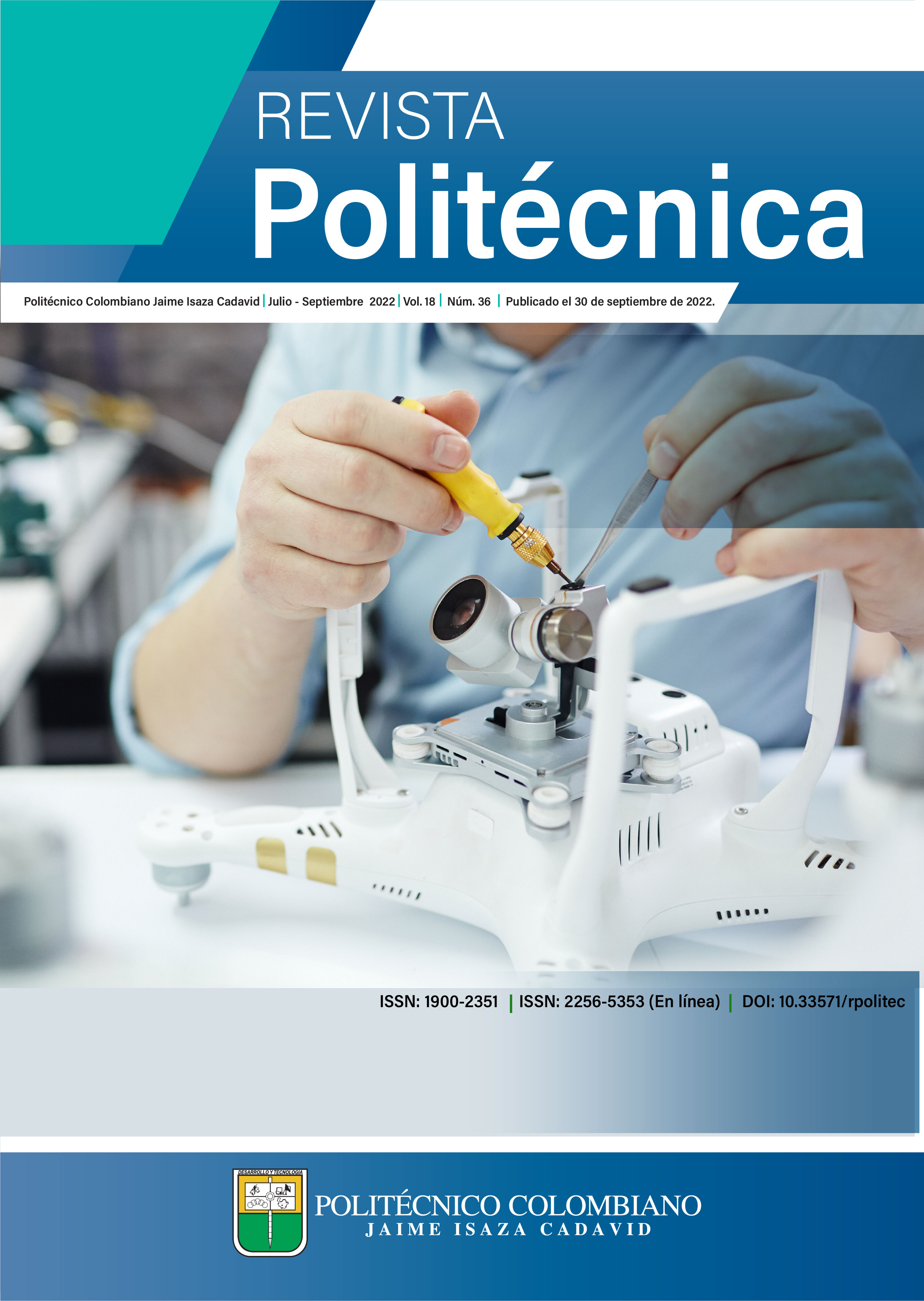Evaluación de las propiedades físico-mecánicas de adoquines de hormigón fabricados con residuos de construcción y demolición
DOI:
https://doi.org/10.33571/rpolitec.v18n36a1Palabras clave:
Agregado grueso reciclado; adoquín; residuos de construcción y demolición; resistencia a la flexión; absorción de aguaResumen
En este estudio se fabricaron adoquines de concreto sustituyendo el agregado grueso natural por agregado grueso reciclado. Los porcentajes de sustitución fueron del 15%, 30% y 45%. Las principales características estudiadas en los agregados gruesos fueron la granulometría, la densidad aparente y la densidad específica. Por otro lado, las principales características estudiadas en los adoquines fueron la absorción de agua, la densidad y la resistencia a la flexión. Se observó que la densidad de los adoquines disminuyó al aumentar el porcentaje de sustitución del agregado grueso reciclado debido a la alta porosidad presente en los agregados reciclados. A su vez, se encontró que los adoquines con una sustitución del 15% fueron los únicos que alcanzaron la resistencia a la flexión indicada en la norma. Se concluyó que los adoquines fabricados pueden ser utilizados en zonas de alta pluviosidad o con altos niveles freáticos, así como en parqueaderos o aceras.
Métricas de artículo
Resumen: 562 PDF: 289 HTML: 125Métricas PlumX
Citas
Sani, R., & Nzihou, A. (2017). Production of clay ceramic using agricultural wastes: Study of properties, energy savings and environmental indicators. Applied Clay Science, 146, 106-114. https://doi.org/10.1016/j.jclepro.2013.11.005
Cabeza, L. F., Rincón, L., Vilariño, V., Pérez, G., & Castell, A. (2014). Life cycle assessment (LCA) and life cycle energy analysis (LCEA) of buildings and the building sector: A review. Renewable and Sustaina-ble Energy Reviews, 29, 394-416. https://doi.org/10.1016/j.rser.2013.08.037
Scrivener, K. L., & Nonat, A. (2011). Cement and Concrete Research Hydration of cementitious materi-als, present and future. Cement and Concrete Research, 41(7), 651-665. https://doi.org/10.1016/j.cemconres.2011.03.026
Kisku, N., Joshi, H., Ansari, M., Panda, S. K., Navak, S., & Dutta, S. C. (2017). A critical review and assessment for usage of recycled aggregate as sustainable construction material. Construction and Build-ing Materials, 131, 721-740. https://doi.org/10.1016/j.conbuildmat.2016.11.029
Hossain, U., Sun, C., Hong, Y., & Xuan, D. (2018). Evaluation of environmental impact distribution methods for supplementary cementitious materials. Renewable and Sustainable Energy Reviews, 82, 597-608. https://doi.org/10.1016/j.rser.2017.09.048
Shi, C., Li, Y., Zhang, J., Li, W., Chong, L., & Xie, Z. (2016). Performance enhancement of recycled concrete aggregate - A review. Journal of Cleaner Production, 112, 466-472. https://doi.org/10.1016/j.cemconres.2011.03.026
Becerra-Duitama, J. A., & Rojas-Avellaneda, D. (2022). Pozzolans: A review. Engineering and Applied Science Research, 49(4), 495-504. https://doi.org/10.14456/easr.2022
Wu, H., Zuo, J., Zillante, G., Wang, J., & Duan, H. (2021). Environmental impacts of cross-regional mo-bility of construction and demolition waste: An Australia Study. Resources, Conservation and Recycling, 174, 105805. https://doi.org/10.1016/j.resconrec.2021.105805
Zhang, J., Ding, L., Li, F., & Peng, J. (2020). Recycled aggregates from construction and demoli-tion wastes as alternative filling materials for highway subgrades in China. Journal of Cleaner Produc-tion, 255, 120223. https://doi.org/10.1016/j.jclepro.2020.120223
Vieira, C. S., & Pereira, P. M. (2015). Use of recycled construction and demolition materials in ge-otechnical applications: A review. Resources, Conservation and Recycling, 103, 192-204. https://doi.org/10.1016/j.resconrec.2015.07.023.
Rahman, M., Imteaz, M., Arulrajah, A., & Disfani, M. M. (2014). Suitability of recycled construction and demolition aggregates as alternative pipe backfilling materials. Journal of Cleaner Production, 66, 75-84. https://doi.org/10.1016/j.jclepro.2013.11.005
Rahman, M. A., Arulrajah, A., Piratheepan, J., Bo, M. W., & Imteaz, M. A. (2014). Resilient Modu-lus and Permanent Deformation Responses of Geogrid-Reinforced Construction and Demolition Mate-rials. Journal of Materials in Civil Engineering, 26(3), 512-519. https://doi.org/10.1061/(asce)mt.1943-5533.0000824
Monrose J., Tota-Maharaj, K., & Mwasha, A. (2019). Assessment of the physical characteristics and stormwater effluent quality of permeable pavement systems containing recycled materials. Road Materials and Pavement Design, 22(4), 1-33. https://doi.org/10.1080/14680629.2019.1643397
ICONTEC (2018). NTC 2017 Adoquines de concreto para pavimentos. Instituto Colombiano de Normas Técnicas y Certificación (ICONTEC)
Kumar, G., Shrivastava, S., & Gupta, R. C. (2020). Paver blocks manufactured from construction & demolition waste. Materials Today: Proceedings, 27, 311-317. https://doi.org/10.1016/j.matpr.2019.11.039
Evangelista, L., Guedes, M., De Brito, J., Ferro, A. C., & Pereira, M. F. (2015). Physical, chemical and mineralogical properties of fine recycled aggregates made from concrete waste. Construction and Building Materials, 86, 178-188. https://doi.org/10.1016/j.conbuildmat.2015.03.112
Lovato, P. S., Possan, E., Molin, D. C. C. D., Masuero, Â. B., & Ribeiro, J. L. D. (2012). Model-ling of mechanical properties and durability of recycled aggregate concretes. Construction and Build-ing Materials, 26(1), 437-444. https://doi.org/10.1016/j.conbuildmat.2011.06.043
Pepe, M., Toledo Filho, R. D., Koenders, E. A. B., & Martinelli, E. (2014). Alternative processing procedures for recycled aggregates in structural concrete. Construction and Building Materials, 69, 124-132. https://doi.org/10.1016/j.conbuildmat.2014.06.084
Publicado
Cómo citar
Número
Sección
Licencia
Derechos de autor 2022 Jhonatan Alexander Becerra-Duitama, Jhonattan Andrés Echeverría-Avella , Paula Andrea Galvis-Echeverría

Esta obra está bajo una licencia internacional Creative Commons Atribución-NoComercial-CompartirIgual 4.0.


























